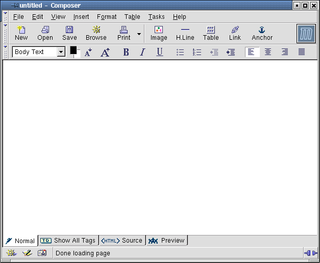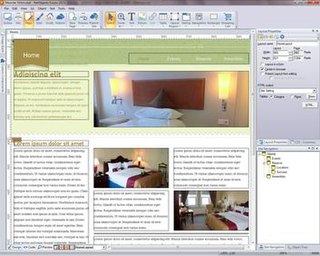Related Research Articles

A website is a collection of web pages and related content that is identified by a common domain name and published on at least one web server. Websites are typically dedicated to a particular topic or purpose, such as news, education, commerce, entertainment, or social media. Hyperlinking between web pages guides the navigation of the site, which often starts with a home page. The most-visited sites are Google, YouTube, and Facebook.
Web design encompasses many different skills and disciplines in the production and maintenance of websites. The different areas of web design include web graphic design; user interface design ; authoring, including standardised code and proprietary software; user experience design ; and search engine optimization. Often many individuals will work in teams covering different aspects of the design process, although some designers will cover them all. The term "web design" is normally used to describe the design process relating to the front-end design of a website including writing markup. Web design partially overlaps web engineering in the broader scope of web development. Web designers are expected to have an awareness of usability and be up to date with web accessibility guidelines.
Desktop publishing (DTP) is the creation of documents using dedicated software on a personal ("desktop") computer. It was first used almost exclusively for print publications, but now it also assists in the creation of various forms of online content. Desktop publishing software can generate page layouts and produce text and image content comparable to the simpler forms of traditional typography and printing. This technology allows individuals, businesses, and other organizations to self-publish a wide variety of content, from menus to magazines to books, without the expense of commercial printing.
A HTML editor is a program used for editing HTML, the markup of a web page. Although the HTML markup in a web page can be controlled with any text editor, specialized HTML editors can offer convenience, added functionality, and organisation. For example, many HTML editors handle not only HTML, but also related technologies such as CSS, XML and JavaScript or ECMAScript. In some cases they also manage communication with remote web servers via FTP and WebDAV, and version control systems such as Subversion or Git. Many word processing, graphic design and page layout programs that are not dedicated to web design, such as Microsoft Word or Quark XPress, also have the ability to function as HTML editors.

Macromedia, Inc., was an American graphics, multimedia, and web development software company (1992–2005) headquartered in San Francisco, California, that made products such as Flash and Dreamweaver. It was purchased by its rival Adobe Systems on December 3, 2005.

Microsoft FrontPage is a discontinued WYSIWYG HTML editor and website administration tool from Microsoft for the Microsoft Windows line of operating systems. It was branded as part of the Microsoft Office suite from 1997 to 2003. Microsoft FrontPage has since been replaced by Microsoft Expression Web and SharePoint Designer, which were first released in December 2006 alongside Microsoft Office 2007, but these two products were also discontinued in favor of a web-based version of SharePoint Designer, as those three HTML editors were desktop applications.
Adobe Dreamweaver is a proprietary web development tool from Adobe. It was created by Macromedia in 1997 and developed by them until Macromedia was acquired by Adobe Systems in 2005.

Mozilla Composer is the former free and open-source HTML editor and web authoring module of the Mozilla Application Suite. It was used to create and to edit web pages, e-mail, and text documents, and available for Windows, macOS and Linux. Composer was a graphical WYSIWYG HTML editor to view, write and edit HTML source code.
Web standards are the formal, non-proprietary standards and other technical specifications that define and describe aspects of the World Wide Web. In recent years, the term has been more frequently associated with the trend of endorsing a set of standardized best practices for building web sites, and a philosophy of web design and development that includes those methods.

Amaya is a discontinued free and open source WYSIWYG web authoring tool with browsing abilities.
HomeSite was an HTML editor originally developed by Nick Bradbury. Unlike WYSIWYG HTML editors such as FrontPage and Dreamweaver, HomeSite was designed for direct editing, or "hand coding", of HTML and other website languages.

BBEdit is a proprietary text editor made by Bare Bones Software, originally developed for Macintosh System Software 6, and currently supporting macOS.
A web content management system is a software content management system (CMS) specifically for web content. It provides website authoring, collaboration, and administration tools that help users with little knowledge of web programming languages or markup languages create and manage website content. A WCMS provides the foundation for collaboration, providing users the ability to manage documents and output for multiple author editing and participation. Most systems use a content repository or a database to store page content, metadata, and other information assets the system needs.
The following tables compare general and technical information for a number of HTML editors.
Tableless web design is a web design method that avoids the use of HTML tables for page layout control purposes. Instead of HTML tables, style sheet languages such as Cascading Style Sheets (CSS) are used to arrange elements and text on a web page.

NetObjectsFusion (NOF) is a web design tool, from 1996 to 2001 developed and distributed by NetObjects, Inc., marketed from 2001 until 2009 by Web.com, which bought the application in 2001, and from July 2009 on distributed again by the re-established NetObjects, Inc.
A software widget is a relatively simple and easy-to-use software application or component made for one or more different software platforms.

Webydo is a cloud-based web design platform that allows designers to create advanced HTML5, responsive websites with a built-in CMS, without writing code. Webydo works with the WYSIWYG principle. This platform utilizes tools similar to those used in other software such as Adobe Photoshop or InDesign, but with the ability to design directly in the browser. Designers can drag and drop their design elements on canvas, and Webydo's cloud software automatically generates cross-browser and cross-platform W3C validated HTML code as well as a built-in CMS for dynamic updates changed by the website owner.
References
- ↑ Mark Lawson (August 9, 2005). "Berners-Lee on the read/write web". BBC News . Archived from the original on 5 July 2022.
- ↑ "A Look Back At The Very First Website Ever Launched, 30 Years Later". NPR.org. Archived from the original on 9 July 2022.
- ↑ "Amaya Home Page". World Wide Web Consortium. December 9, 2009. Retrieved September 29, 2010.
- ↑ "Yahoo! buys GeoCities". CNN.com. January 28, 1999. Retrieved September 18, 2014.